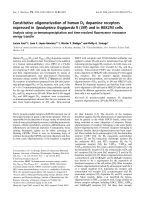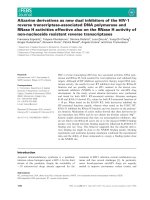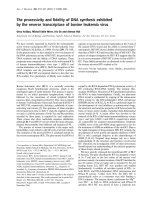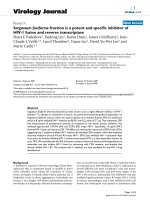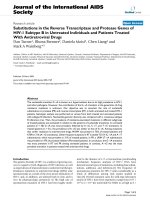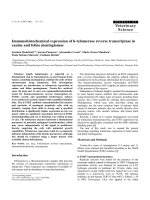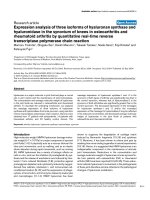Human telomerase reverse transcriptase (hTERT) overexpression modulates intracellular redox balance and protects cancer cells from apoptotic cell death
Bạn đang xem bản rút gọn của tài liệu. Xem và tải ngay bản đầy đủ của tài liệu tại đây (6.97 MB, 200 trang )
HUMAN TELOMERASE REVERSE TRANSCRIPTASE
(hTERT) OVEREXPRESSION MODULATES INTRACELLULAR REDOX
BALANCE AND PROTECTS CANCER CELLS FROM
ROS MEDIATED CELL DEATH
INTHRANI D/O RAJA INDRAN
(BSc. (Hons.), NUS)
A THESIS SUBMITTED
FOR THE DEGREE OF DOCTOR OF PHILOSOPHY
DEPARMENT OF PHYSIOLOGY
YONG LOO LIN SCHOOL OF MEDICINE
NATIONAL UNIVERSITY OF SINGAPORE
2009
ACKNOWLEDGEMENTS
This thesis would not have been possible if not for the many special people who have
stood by me and guided me along in my last four years. It gives me great pleasure to
have this opportunity to thank these wonderful people.
To Prof Shazib Pervaiz, I owe him special thanks for the unwavering faith he had
placed in me especially when I was struggling in the initial phases of my project. His
relentless encouragement, enthusiasm and knowledge have been truly inspiring and
have added immense value to the calibre of this thesis. I will never forget the random
little pep talks, the times spent in non intellectual pursuit discussing the special
attributes of 3am and the reasonable and unreasonable grilling sessions we had
during lab meetings. Thank you boss for these cherished times and for simply being
there for me over the years.
To Dr Prakash Hande, I extend my sincere thanks to him. I am truly grateful for the
autonomy, freedom and timely advice he gave me in manoeuvring my project over the
last four years. The efforts he expended in getting hold of the numerous plasmids and
cell lines that I needed, helped open some of the crucial doors in my project. Thank
you very much for all the support you have given me, sir.
To my lab mates from both ROS Biology and Apoptosis lab and Genome Instability
lab, all of you have made this journey an immensely memorable one with all your
little quirks, random words of wisdom, motivation and constructive advice. I am
privileged to have known all of you and am thankful for the valuable friendships that
have been forged through the years. I will never forget our late nights in lab, our
communal ranting against antibodies that never worked and our inspirational meal
sessions. My special thanks to the class of 2005, Sinong, Chewy, Zhi Xiong, Greg,
Lakshmi, Ai Kia, Swamy and Grace for having shared my happiness, frustrations,
successes and failures and for being a huge source of support for me. Thank you all
loads.
I would also like to give special mention to Dr Jayshree and Kartini for taking care of
the needs of the lab and being such patient and loving people whom I could turn to
i
anytime to relieve my frustrations. Together both of you have had a pseudo calming
effect on the lab environment. In addition, I have also learnt and benefited largely
from your immense wealth of scientific experience. Thank you very much.
My special thanks also goes out to Dr Alan Premkumar and Dr Andrea Holmes for
their kind guidance and resources that have largely shaped and developed my
research ideas and inevitably contributed to the progress of my project. Thank you
very much!
To all my close friends Sharon, Gerry, Nurul, Ruben, Chandra, Soy, Waseem, Tahira
Praveena, Prabha, Sajitha, and Vanitha thank you very much for you kindness, love
and patience. Thank you for the lifts and company that have made my hour and a half
long journeys between campus and home seem like nothing. Thank you for your
unyielding support, the little random notes of encouragement and the colour you have
added to my life. You guys are truly special and I love you all!
Lastly, to my family, the people without whom, I would have never made it this far in
life. To my most beloved parents, even in their toughest times, they only had words of
love and encouragement for me. Their giving nature supersedes everything. To my
Amma and Naina, thank you very much for your unconditional love and motivation all
these years. To my sister, who has been one of the biggest pillars of strength in my
life, thank you for shielding me, grooming me, inspiring me and for the confidence
you placed in me. Watching you, I have learnt the true meaning of resilience. Thank
you Ka! Also, special thanks to my Jega for his kind love, patience and understanding
especially during some of my very stressful times. Thanks for being by my side. I love
you all very much.
ii
TABLE OF CONTENTS
Acknowledgements ii
Table of contents iv
Summary x
List of figures xii
List of abbreviations xv
INTRODUCTION………………………………………………………… 1
1. CANCER.… …………………………………………………………………1
2. TELOMERES AND TELOMERASE…………………………………… 2
2.1. Telomeres and telomerase regulation….………………………………………4
2.1.1. Transcriptional regulation of hTERT. ……………………… …………… 5
2.1.2. Post transcriptional modification of hTERT………………… ……………7
2.2. Senescence and immortalization………………………………………………9
2.3. The non canonical roles of telomerase……………… ………………… ….12
3. REACTIVE OXYGEN SPECIES………………………………………….13
3.1. Different types of ROS …………………………………………………… 14
3.2. Sources of ROS ……… …………………… …………………………… 15
3.3. Functions of ROS…………………………………………………………….16
4. THE CELLULAR ANTIOXIDANT DEFENCES……………………… 18
4.1. Superoxide dismutases……….…………………………………………… 20
4.2. Catalase…………………………….……………………………………… 21
4.3. Glutathione and glutathione dependent enzymes….…………………………22
4.3.1. Glutathione …………………………… ………………………………… 22
iii
4.3.2. GSH synthesis.…………………………… ……………………………… 24
4.3.3. Glutathione reductase.…………………………… …………………… ….25
4.3.4. Glutathione peroxidase.…………………………… …………………….…26
4.4. Peroxiredoxins……………… ………………………………………………27
4.5. Thioredoxins……………………… ……………………………………… 29
5. hTERT AND ROS………… …………………………………………… 30
5.1. Effects of oxidative stress on hTERT……………… ……………………….31
5.2. Effects of hTERT on oxidative stress…… ………………………………….33
6. CELL DEATH…………………………………………………………… 34
6.1. Necrosis…… ……………………………………………………………….35
6.2. Autophagy……………………………………………………………………36
6.3. Apoptosis…… ………………………………………………………………36
6.3.1. Type I – extrinsic or receptor mediated pathway…………………………….37
6.3.2. Type II – intrinsic or mitochondria mediated pathway…………………… 37
6.4. Influence of ROS on cell death signalling……………………………………38
6.5. Mitochondria membrane permeabilization….……………………………….41
6.6. Regulation of apoptosis by Bcl-2 family of protein………………………….43
7. CANCER THERAPY, ROS AND TELOMERASE…………………… 44
AIMS……………………………………………………………… 47
MATERIALS AND METHODS……….………………………………… 50
1. Cell Lines and plasmids…………………………………………………….…50
2. Antibodies…………………………………………………………………… 50
3. Chemicals………………………………………………………………….… 51
4. Cell culture…………………………………………………………………….51
iv
5. Plasmid information ………………………………………………………52
6. Amplification and purification of plasmids………………………………… 53
7. Transient transfection ……………………………………………………….55
8. Generation of stable clones……………… ……………………………… 56
9. Silencing……………………………… …………………………………….56
10. Crystal Violet cell viability assay…………………………………………… 57
11. Analysis of DNA fragmentation by propidium iodide staining……………….57
12. Colony forming assay… …………………………………………………….58
13. Assessment of intracellular ROS levels via CM-H
2
DCFDA staining……… 58
14. Assessment of mitochondrial O
2
levels via MitoSOX Red staining…………58
15. Assessment of mitochondrial membrane potential using DIOC
6
…………… 59
16. Assessment of intracellular reduced / oxidised glutathione levels……………59
17. Glutathione peroxidase assay… ………………………………………….… 62
18. Glutathione reductase assay……………………………………………… ….63
19. Assessment of telomerase activity using TRAP assay……………………… 64
20. Assessment of Cytochrome c oxidase activity……………………………… 65
21. Detection of hTERT gene expression by RT-PCR………………………… 66
22. Determination of protein expression by western blot analysis……………… 66
22.1. Buffers used for western blot analysis……………………………………….67
23. Isolation of mitochondrial and cytosolic fractions……………………………69
24. Isolation of nuclear and cytosolic fractions………………………………… 70
25. Measurements of protein concentration (Bradford Assay)………………… 70
26. Statistical analysis…………………………………………………………… 71
v
RESULTS….…………….……….……………………………………… 72
1. hTERT AND ROS CAN CROSS REGULATE EACH OTHER … 72
1.1. hTERT expression and activity is regulated by H
2
O
2
in a dose dependant
manner…….……………………………………………………….…………72
1.2. hTERT localization can be modulated by exposure to ROS…………… 74
1.3. Transient hTERT overexpression can modulate intracellular ROS
levels……………………………………………………….……………… 76
1.4. Transient hTERT overexpression resists the increase in intracellular ROS
levels following treatment with H
2
O
2
………… ………………………… 79
1.5. Transient hTERT overexpression resists the increase in intracellular ROS
induction following treatment with the ROS inducing compound C1……….82
1.6. Generation of stable hTERT overexpressing cells and verification of hTERT
expression and activity in stable clones 84
1.7. Stable hTERT overexpression reduces basal intracellular ROS…………… 86
1.8. Stable hTERT overexpression blocks intracellular ROS induction
following treatment with H
2
O
2
or C1.…… ………………………….…….89
1.9. Stable hTERT overexpression alters hTERT expression and localization
patterns……………………………………………………………………….92
2. UNRAVELING THE MECHANISMS BY WHICH hTERT
EXPRESSION MODULATES INTRACELLULAR REDOX
STATUS………………………………………………………………… 94
2.1. Assessment of critical antioxidant defences………………………………….94
2.1.1. Assessment of intracellular SOD and Catalase expression following
hTERT overexpression………… …………………………………….….…95
2.1.2. Assessment of intracellular Peroxiredoxin and Thioredoxin levels
following hTERT overexpression… … ……… ……………….…………98
2.1.3. hTERT overexpression increases the rate of regeneration of
Peroxiredoxins from the hyperoxidised forms ……………………….…100
2.1.4. hTERT overexpressing cells maintain a higher intracellular GSH/GSSG
ratio following H
2
O
2
treatment………………………………………… …102
2.1.5. hTERT overexpressing cells maintain higher intracellular mitochondrial
GSH levels following H
2
O
2
treatment………………… 104
vi
2.1.6. hTERT overexpression results in earlier and sustained induction of
GCLC levels following H
2
O
2
treatment.……………………… ………… 106
2.1.7. hTERT overexpression results in differential regulation of Glutathione
dependant enzymatic activities……….……………………………….… 107
2.2. hTERT overexpression results in improved mitochondrial function……….110
2.2.1. hTERT localizes to the mitochondria…………………………………….…110
2.2.2. hTERT expression increases Cytochrome c oxidase activity………………112
3. THE EFFECTS OF hTERT EXPRESSION IN AN ALTERNATIVE
MODEL; SH-SY5Y CELLS ………………………………… ………….114
3.1. Studying the influence of hTERT expression in SH-SY5Y Cells …… 114
3.1.1. hTERT silencing in SH-SY5Y cells potentiate the increase in intracellular
ROS levels following treatment with H
2
O
2
………………… 114
3.1.2. hTERT silencing reduces the rate of Peroxiredoxin regeneration from
the hyperoxidised form in SH-SY5Y cells…………………………….……118
3.1.3. hTERT silencing results in reduced GSH/GSSG ratios in SH-SY5Y cells
following H
2
O
2
treatment …………………………………………………118
4. hTERT EXPRESSION IMPAIRS ROS INDUCED CHANGES IN
INTECELLULAR MILIEU AND PROTECTS FROM CELL
DEATH…………………………………………… 120
4.1. Induction of cytosolic acidification by H
2
O
2
and C1 is reduced in
hTERT overexpressing Cells…………………………………………….….120
4.2. Mitochondrial Bax translocation and release of pro-apoptogenic factors
is partially inhibited in hTERT overexpressing cells…… ………… 124
4.3. Dissipation of the mitochondrial membrane potential (
m
) is reduced
in hTERT overexpressing cells… …………………………………… 126
4.4. hTERT overexpression can protect cells from H
2
O
2
induced cell death 130
4.5. hTERT overexpression can protect cells from C1 induced cell death…… 135
vii
DISCUSSION…………………………………………………………….…138
1. THE USE OF DIFFERENT MODELS IN THIS STUDY…… …138
1.1. The use of HeLa cell Line and the limitations in telomerase biology…… 138
1.2. The use of transient and stable transfection models in this study……… …139
1.3. The use of H
2
O
2
and C1 as tools to investigate the relationship between
hTERT and ROS and the different time points at which the investigations
were performed.………………….………………………….………………141
2. ESTABLISHING THE RELATIONSHIP BETWEEN hTERT
AND ROS………………………………………………………………… 142
2.1. ROS mediated suppression and nuclear export of hTERT can be
antagonized by hTERT overexpression……… ……………………… ….142
2.2. hTERT expression significantly reduces basal intracellular ROS levels
and antagonize the increase in cellular ROS levels in response to
oxidative stress…………………………………………………………… 144
3. MECHANISMS THAT hTERT CAN EMPLOY TO MODULATE
CELLULAR ROS LEVELS…………………………………………… 145
3.1. Cellular antioxidant defences…………………………………………… 146
3.2. hTERT expression can enhance the Glutathione antioxidant defences…….147
3.3. hTERT expression improves Peroxiredoxin regeneration…………… … 149
3.4. hTERT expression enhances mitochondrial antioxidant defences……… 150
3.5. How hTERT could modulate the antioxidant defences? 151
3.6. The role of hTERT at the mitochondria…………………………………….154
4. PHYSIOLOGICAL SIGNIFICANCE OF MODULATION OF
CELLULAR REDOX BALANCE BY hTERT……………………… 156
4.1. hTERT expression creates an intracellular environment unfavourable
for eliciting death triggers…………………………………… ……… 156
4.2. hTERT expression protects cells from apoptotic triggers………………… 158
viii
5. CONCLUDING REMARKS………………………………………… …160
6. REFERENCES…………………………………………………………….164
7. APPENDIX……………………………………………………………… 182
ix
SUMMARY
The human telomerase reverse transcriptase (hTERT) is the catalytic subunit of the
telomerase holoenzyme which is critical for the maintenance of telomere lengths and
the enhanced replicative capacity of the cells. Being silenced during embryonic
differentiation in normal cells, its reactivation in over 85% of cancer cells has made
hTERT an attractive therapeutic target in the field of cancer. However in recent years
there has been accumulating evidence to suggest that hTERT may play a role in cells
that deviates from its conventional functions of telomere maintenance and
immortalization. In this light, several studies have shown that expression of hTERT
can confer resistance against apoptotic triggers and oxidative stress. As such, this
study originated with the aim of establishing how hTERT can be modulated by ROS
and more critically if hTERT can modulate the intracellular redox status thus
bestowing survival advantages onto the cells.
In this regard, this thesis provides evidence to show that hTERT expression can
significantly reduce the basal intracellular ROS levels and antagonize the increase in
cellular ROS levels in response to both exogenous (hydrogen peroxide [H
2
O
2
]) and
endogenous (C1) ROS triggers. Indeed both the transient and stable expression of
hTERT abrogated the surge in cellular ROS levels following treatment with H
2
O
2
and
a ROS inducing drug C1. In addition, hTERT silencing potentiated the increase in
cellular ROS levels following exposure to oxidative stress. The discovery of this non
canonical function of hTERT in modulating cellular redox status led onto further
investigations to unravel the plausible mechanisms by which hTERT expression can
modulate the ROS levels. In this regard, the assessment of the critical antioxidant
defences and mitochondrial function both of which are pertinent in the regulation of
x
cellular redox balance have shown that hTERT expression can have significant
positive impact on key antioxidant defences such as the glutathione system,
peroxiredoxin activity and Mn SOD expression. In addition it has also shown a role
for hTERT at the mitochondria in increasing mitochondrial COX activity. In
unravelling the extensive influence of hTERT expression on cellular redox status, the
physiological relevance of these findings on cell fate was assessed next. Previous
findings in the lab has established that H
2
O
2
added exogenously or triggered
endogenously using C1 is a stimulus for cytosolic acidification, which creates a
permissive intracellular milieu for death execution. Here, we demonstrate that these
detrimental effects of ROS on the cells such as cytosolic acidification and the
subsequent mitochondrial engagement could be antagonized by hTERT expression
thus conferring significant protection from the cell death.
xi
LIST OF FIGURES
INTRODUCTION
Figure 1: The end replication problem
Figure 2: Telomere elongation by telomerase.
Figure 3: Generation of ROS and their control by antioxidants.
Figure 4: Structure of Glutathione
Figure 5: Overview of GSH metabolism
Figure 6: Diagrammatic representation of the glutathione redox cycle
Figure 7: Catalytic and inactivation/reactivation cycles of Prxs.
Figure 8: Enzymatic reactions of the thioredoxin system.
Figure 9: Graphic summary of major physiological functions of the mammalian
thioredoxin system.
Figure 10: Apoptotic pathways.
Figure 11: Hypothetical schematic of the mitochondrial permeability transition
pore
Figure 12: Verification of plasmids.
RESULTS
Figure 13: Effect of H
2
O
2
on hTERT expression and activity.
Figure 14: hTERT translocation upon treatment with H
2
O
2
.
Figure 15: Transient hTERT overexpression reduces basal intracellular ROS.
Figure 16: Transient hTERT overexpression reduces mitochondrial superoxide
levels
Figure 17: Transient hTERT overexpressing cells displays lower intracellular
ROS when treated with H
2
O
2
.
Figure 18: Transient hTERT overexpressing cells displays lower intracellular
ROS when treated with C1.
xii
Figure 19: Stable transfection of HeLa cells with pBabe-Neo and
pBabe-hTERT-Neo
Figure 20: Stable hTERT overexpression reduces basal intracellular ROS.
Figure 21: Stably hTERT overexpressing cells displays lower intracellular
ROS when treated with H
2
O
2
.
Figure 22: Stably hTERT overexpressing cells displays lower intracellular ROS
when treated with C1.
Figure 23: hTERT expression and localization in Neo and HT1 cells following
H
2
O
2
treatment.
Figure 24: Assessment of intracellular SOD and Catalase expression following
hTERT overexpression and H
2
O
2
treatment
Figure 25: Regulation of Peroxiredoxins and Thioredoxin.
Figure 26: hTERT overexpression increases the rate of Peroxiredoxin
regeneration from the hyperoxidised form.
Figure 27: hTERT overexpressing cells maintain a higher intracellular
GSH/GSSG ratio following H
2
O
2
treatment
Figure 28: hTERT overexpressing cells maintain higher intracellular
mitochondrial GSH levels following H
2
O
2
treatment
Figure 29: hTERT overexpression results in earlier and sustained induction of
GCLC levels following H
2
O
2
treatment
Figure 30: Glutathione Peroxidase Activity is increased with hTERT
overexpression.
Figure 31: Glutathione Reductase activity remains unchanged with hTERT
expression
Figure 32: hTERT localizes to the mitochondria.
Figure 33: hTERT overexpression increases the COX activity in cells.
Figure 34: hTERT silencing increases basal intracellular ROS levels.
Figure 35: hTERT silencing accentuates the increase in intracellular ROS levels
following H
2
O
2
treatment
Figure 36: hTERT silencing reduces the rate of Peroxiredoxin regeneration from
the hyperoxidised form following H
2
O
2
treatment
Figure 37: hTERT silencing in SH-SY5Y cells reduces intracellular GSH/GSSG
ratio following H
2
O
2
treatment.
xiii
Figure 38: H
2
O
2
induced cytosolic acidification is reduced in hTERT
overexpressing cells.
Figure 39: C1 induced cytosolic acidification is reduced in hTERT
overexpressing cells
Figure 40: hTERT overexpression partially inhibits Bax translocation and
cytochrome c and Smac release.
Figure 41: hTERT overexpression reduces the drop in membrane potential
following treatment with H
2
O
2
.
Figure 42: hTERT overexpression reduces the drop in membrane potential
following treatment with C1.
Figure 43: hTERT overexpression can protect from H
2
O
2
mediated apoptosis.
Figure 44: Cell cycle analysis to show that hTERT overexpression can protect
from H
2
O
2
mediated apoptosis.
Figure 45: hTERT overexpression promotes the colony-forming ability of cells
which have been treated with H
2
O
2
.
Figure 46: hTERT overexpression can protect from C1 mediated apoptosis.
Figure 47: hTERT overexpression promotes the colony-forming ability of cells
which have been treated with C1.
DISCUSSION
Figure 48: Mechanism by which hTERT can confer protection against oxidative
death triggers
xiv
LIST OF ABBREVIATIONS
m Mitochondria transmembrane potential
AIF Apoptosis inducing factor
AP1 Activator protein 1
ATG Autophagy related genes
ATP Adenosine triphosphate
Bad Bcl-2 antagonist of cell death
Bak Bcl-2 antagonist/killer
Bax Bcl-2 associated X protein
Bcl-2 B-cell lymphoma protein 2
Bcl-xl B-cell lymphoma-extra large
BH Bcl-2 homology
BSA Bovine serum albumin
CM-H2DCFDA 5-(and-6)-chloromethyl-2.,7-dichlorofluorescin diacetate
COX Cytochrome c oxidase
Cyt. C Holocytochrome c
DIABLO Direct IAP-binding protein with low pI
DIOC6 5,3,3’-dihexyloxacarbocyanine iodide
DMEM Dulbecco’s Modified Eagle’s Medium
DNA Deoxyribonucleic Acid
DR Death receptor
DTT Dithiothreitol
EDTA Ethylenediaminetetraacetic acid
EGTA Ethyleneglycotetraacetic acid
EndoG Endonuclease G
ER Endoplasmic reticulum
Et OH Ethanol
EtBr Ethidium bromide
ETC Electron transport chain
FBS Fetal bovine serum
G418 Geneticin
GCL Glutamate cysteine ligase
GCLC Glutamate cysteine ligase catalytic subunit
xv
GPx Glutathione peroxidase
GR Glutathione reductase
GSH Reduced glutathione
GSSG Oxidised glutathione
H2O2 Hydrogen peroxide
HA Hemagglutinin
HCl Hydrochloric acid
HEPES 4-(2-hydroxyethyl)-1-piperazineethanesulfonic acid
hTERT Human telomerase reverse transcriptase
hTR Human telomerase RNA
IAP Inhibitor of apoptosis protein
IMM Inner mitochondrial membranes
KCl Potassium chloride
KH
2
PO
4
Potassium dihydrogen phosphate
KOH Potassium hydroxide
LB Lysogeny broth
Mcl-1 Induced myeloid leukemia cell differentiation protein
MEF Mouse embryonic fibroblast
MgCl
2
Magnesium chloride
Mitosox Hexyl triphenylphosphonium cation (TPP+)-HE
MMP Mitochondria membrane permeabilization
MPT Membrane permeability transition
NaCl Sodium chloride
NAD β-nicotinamide adenine dinucleotide
NADPH β-Nicotinamide Adenine Dinulcleotide Phosphate, Reduced
NaOH Sodium hydroxide
NEM N-ethyl maleimide
NFкB Nuclear factor of kappa light polypeptide
NHE Na+/H+ exchanger
NO. Nitric oxide radical
NOS Nitric oxide synthase
NP-40 Nonyl phenoxylpolyethoxylethanol
O
2
Superoxide
OH
.
Hydroxide radical
xvi
xvii
OMM Outer mitochondrial membranes
ONOO
-
Peroxynitrite
OPT O–Phthaladehyde
PARP Poly(ADP-ribose) polymerase
PBS Phosphate buffered saline
PI Propidium iodide
PKC Protein kinase C
PMSF Phenylmethylsulphonyl fluoride
Prx Peroxiredoxin
PTPC Permeability transition pore complex
PUMA p53-upregulated mediator of apoptosis
RNA Ribonucleic acid
RNase Ribonuclease
RNS Reactive nitrogen species
ROS Reactive oxygen species
SDS Sodium dodecyl sulphate
SDS-PAGE SDS-polyacrylamide gel electrophoresis
siRNA Small interfering RNA
SMAC Second mitochondria-derived activator of caspases
SOC Super optimal catabolite
SOD Superoxide dismutase
Sp1 Promoter specificity protein 1
Srx Sulfiredoxin
TCA Trichloroacetic acid
TEMED N,N,N’,N’-tetramethlethylenediamine
Trx Thioredoxin
TrxR Thioredoxin reductase
VDAC Voltage-dependent anion channel
INTRODUCTION
1. CANCER
The progressive transformation of normal human cells to malignant derivatives is a
complex multi step process which requires dynamic alterations to the genome and
successful breaching of intracellular checkpoints. The multiplicity of cellular defences
that are in place to prevent the uncontrolled division and invasion of the cells explains
why cancer is a rare event during the average human life time. However, when the
immune response is lost or compromised, it paves the way for the onset of cancer.
Today, cancer has become one of the leading causes of death in many countries
including Singapore
1
.
Over the last quarter of a century, extensive research in the cancer field has explored
numerous pathways in cancer progression to elucidate effective measures to target
these cancer cells. However there is no single treatment regime that will work for all
cancers for they are controlled by different regulatory circuits, armed with a variety of
adaptive responses and localized in unique microenvironments. Thus, improving
therapeutic efficacy and selectivity and overcoming drug resistance are the major
goals in developing anti cancer agents today.
In order to achieve these goals, exploitation of the intrinsic differences between
normal and cancer cells could be a valuable approach to target cancer cells for cell
death. One of the glaring differences between normal cells and cancer cells is their
difference in telomerase expression. Telomerase is is a multi component
ribonucleoprotein that adds specific DNA repeats (TTAGGG) to the 3' end of DNA
1
Singapore Cancer Registry
1
strands in the telomere regions thus playing a crucial role in telomere maintenance. It
is active in almost all cancer cells but is inactive in most somatic cells with the
exception of a few, including stem cells and germline cells, thus making it an
attractive target for cancer therapy.
2. TELOMERES AND TELOMERASE
Telomeres are specialized structures that cap and preserve chromosomal integrity by
protecting the chromosomal ends from degradation, end to end fusions and
rearrangement (Greider, 1991). They typically consist of tandem GT-rich repeats
(TTAGGG) in humans with a single stranded 3’ overhang. With every cell division,
the telomeres shorten by 50 to 200 base pairs and the inability of the cellular
machinery to replicate the end base pairs is known as the end replication problem
(Figure 1) (Bollmann, 2008; Richter T, 2007). The successive loss of the end base
pairs can critically shorten the chromosome, thus activating growth arrest and cellular
senescence which will be discussed further in the sections below. However, the
reactivation of the telomerase protein can help to overcome the end replication
problem via the addition of telomeric repeats at the 3’ ends of the DNA (Figure 2). A
central question in telom
ere biology has long been the mechanism by which
telomerase maintains telomere length In this regard, previous reports have shown that
the telomerase would preferentially elongate the shortest telomeres in a cell (Bianchi
and Shore, 2008; Hemann et al., 2001; Ouellette et al., 2000), extending the telomeric
G-rich strand through a process that is coupled to the synthesis of the complementary
strand. However, the latest findings by Zhao et al now show that telomerase in human
cancer cells extends most telomeres during every S phase (Zhao et al., 2009).
2
Figure 1: The end replication problem Conventional DNA polymerases synthesize
DNA in the 5’ to 3’ direction and cannot begin synthesis de novo. Instead they use an
8–12-base segment of RNA as a primer (red). The leading strand can, in principle, be
continuously synthesized (green). The lagging strand is synthesized in short, RNA-
primed Okazaki fragments (blue). After extension, the RNA primers are removed and
the gaps filled in by DNA polymerase priming from upstream DNA 3' ends. Removal
of the 5'-most RNA primer generates an 8–12-base gap. Failure to fill in this gap leads
to a small loss of DNA in each round of DNA replication (Vega et al., 2003).
Figure 2: Telomere elongation by telomerase. First, the nucleotides at the extreme
3' end of the telomeric DNA primer are hybridized onto one end of the RNA template
within the RNA domain of the telomerase complex. The 11-nucleotide template
sequence is complementary to that of almost two telomeric repeats (a). The gap at the
end of the template is then filled in by synthesis at the catalytic site of the enzyme
(hTERT), using trinucleoside phosphates. In this way, a complete hexanucleotide
repeat is assembled onto the template (b) (Neidle and Parkinson, 2002)
3
2.1 Telomerase and telomerase regulation
The telomerase holoenzyme consists of a catalytic protein subunit, human telomerase
reverse transcriptase (hTERT), the RNA component of the telomerase (hTR) that is
used as the template by the reveres transcriptase to elongate the telomeric ends, and
telomerase associated proteins such as TEP1 that play a primary role in maintaining
the integrity of the telomeres in normal cells (Greider, 1996). Though hTERT and
hTR are necessary for telomerase activity, it has been shown that telomerase activity
is highly correlated with hTERT expression and not that of hTR (Counter et al.,
1998). In this regard, the catalytic subunit hTERT has been proposed by several
studies to be the rate limiting factor for telomerase activity and will be the focus of
this thesis (Cong et al., 2002; Poole et al., 2001).
Telomerase is differentially regulated under normal and pathological conditions.
While in most human somatic cells telomerase activity is extinguished during
embryonic differentiation, the highly proliferative cells such as stem cells, germ cells,
activated lymphocytes, haematopoietic progenitor cells, intestinal crypt cells,
endometrial cells, basal layer of skin cells and cervical keratinocytes display varying
degrees of telomerase activity (Counter et al., 1995; Hiyama et al., 1995; Kyo et al.,
1999; Yasumoto et al., 1996). Thus, a tight regulation of telomerase and specifically
hTERT expression is crucial to meet the proliferative demands of certain cell types
while preventing excessive proliferation of others to protect from pathological
consequences. Deregulation of telomerase expression has been associated with several
human diseases such as human dyskeratosis congenita which is a multiple systems
disease that results from proliferative deficiencies in highly regenerative tissues such
as the skin, gut and bone marrow (Mitchell et al., 1999). On the other hand the vast
4
majority of human tumours seem to depend on the reactivation of the telomerase
protein to confer cellular immortality. These conditions that arise from the
deregulation of telomerase shed light on the importance of telomerase regulation in
normal human growth and development (Artandi, 2006; Blasco, 2005; Tzukerman et
al., 2002).
2.1.1 Transcriptional regulation of hTERT
The differential expression or regulation of the catalytic subunit of telom
erase,
hTERT, can largely modulate telomerase activity in cells since it is a critical limiting
factor for telomerase activity. hTERT is present as a single gene copy on chromosome
band 5p15.33, the most distal band on the short arm of chromosome 5p. (Bryce et al.,
2000). While several differentially spliced forms of hTERT have been identified, the
protein forms of these alternative spliced forms have not been detected in human
cells. Analysis of the hTERT promoter has shown that it is highly GC-rich. These
GC-rich regions form large CpG regions around the ATG translation start codon,
suggesting that methylation may be involved in the regulation of hTERT expression.
But a site-specific or region-specific methylation pattern correlating with the
expression of the hTERT gene has not been identified (Dessain et al., 2000),
suggesting that epigenetic regulation may not be the main mechanism in telomerase
regulation.
hTERT transcription is activated by several proteins with the principle one being the
oncogenic protein c-myc (Casillas et al., 2003; Kyo et al., 2000). It has been shown
that c-myc can induce the expression of hTERT and hence, telomerase activity in
normal human mammary cells and primary fibroblasts. Overexpression of c-myc has
also resulted in enhanced hTERT promoter activity by direct binding to the E-boxes
5
through heterodimer formation with Max proteins at the promoter region of hTERT
(Xu et al., 2008). E-boxes are DNA sequences which usually lie upstream of a gene in
a promoter region to which transcription factors can bind and enhance the
transcription (Chaudhary and Skinner, 1999; Levine and Tjian, 2003) of the
downstream gene. Mad proteins are antagonists of c-myc and switching from
Myc/Max binding to Mad/Max binding can decrease the promoter activity of hTERT
(Lebel et al., 2007). Another critical regulator of hTERT is the p53 protein. p53
overexpression has been shown to induce transcriptional down regulation of hTERT
in a variety of cancer cell lines independent of cell cycle arrest or apoptosis (Li et al.,
1999; Poole et al., 2001; Shats et al., 2004). Other critical transcriptional activators
would include nuclear factor of kappa light polypeptide (NF-κB), promoter specificity
protein 1 (SP1) and activator protein 1 (AP1) that will be further discussed in the
sections below (Poole et al., 2001).
Telomerase activity has also been shown to be induced by the human papilloma virus
16 E6 (Klingelhutz et al., 1996; Oh et al., 2001). And this activation of telomerase
activity is independent of E6 action on p53 degradation or c-myc induction (Veldman
et al., 2001). This effect is cell-type specific and has been observed in mammary
epithelial cells or keratinocytes but not in fibroblasts. Besides oncogenic proteins such
as c-myc and E6, the telomerase activity can also be increased by steroid hormones
such as estrogen. The presence of estrogen responsive elements in the promoter
region of hTERT serves as a binding site for estrogen receptors, specifically the alpha
form (Cha et al., 2008) and activates hTERT expression in response to estrogenic
stimulation (Kyo et al., 1999). In addition, estrogen can also activate c-myc
expression thereby indirectly contributing to hTERT activation. Drugs that are anti-
6
estrogenic have also been shown to downregulate telomerase activity and have been
explored for their chemotherapeutic potential (Nakayama et al., 2000; Park et al.,
2005).
Telomerase repression has also been extensively studied given the promising potential
of identifying tumour suppressors that could act by downregulating telomerase
activity. Transfer of individual human chromosomes into carcinomas led to the
discovery of chromosomes with the potential to repress telomerase activity. Several
chromosomes such as chromosome 3, 4, 6 and 10 have been identified to contain
putative genes that function as telomerase inhibitors in telomerase positive cells to
antagonize telomerase activity and suppress its expression. The effectiveness of each
of these chromosomes in eliciting anti telomerase function might be cell type
dependent. (Backsch et al., 2001; Cuthbert et al., 1999; Nishimoto et al., 2001).
2.1.2 Post translational modifications of hTERT
Though transcriptional regulation of hTERT is the primary mechanism in controlling
telomerase activity, post translational modifications have been shown to provide
alternative avenues for the regulation of telomerase activity. In this context, it has
been reported that in normal ovarian tissues and uterine leiomyoma, cells have no
detectable telomerase activity despite expressing both hTR and full length hTERT
mRNAs (Ulaner et al., 2000). This lack of correlation between hTERT expression and
telomerase activity has also been noted in peripheral T and B cells, human colon and
renal tissues and tumours. The discordance was attributed to the difference in post
translational modification of hTERT (Minamino et al., 2001; Rohde et al., 2000).
These data imply that even though hTERT expression is essential for telomerase
activity, the expression of hTERT may be insufficient to yield an active telomerase
7
